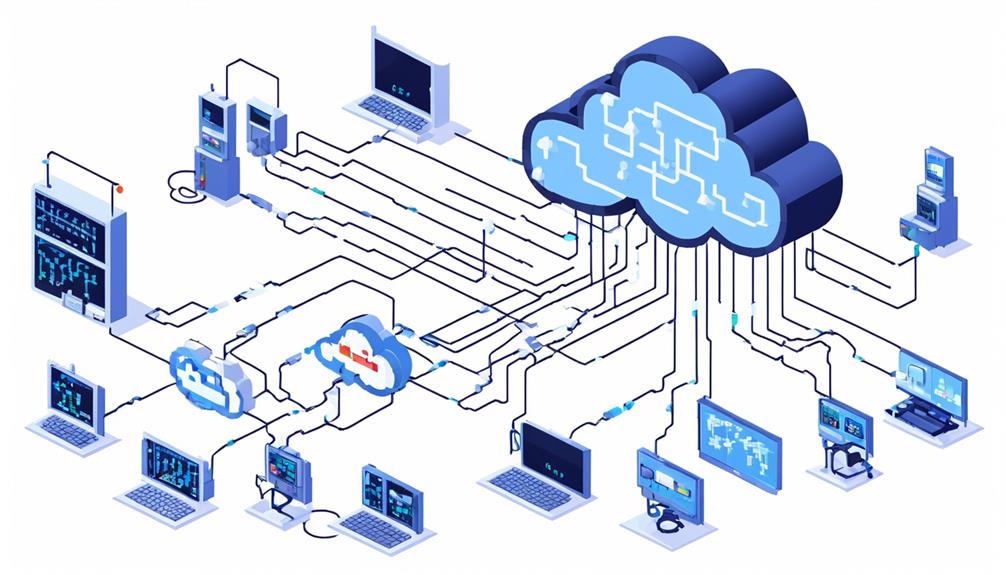Network monitoring hardware tools play a vital role in ensuring the smooth operation and security of computer networks. These tools provide network administrators with valuable insights into real-time and historical network metrics, enabling them to identify and resolve performance issues promptly.
Moreover, network monitoring hardware tools help in detecting hardware failures, software glitches, and potential security threats, safeguarding the network from potential risks. With their scalability and adaptability, these tools offer a unified view of network performance and enhance troubleshooting capabilities.
In this discussion, we will explore the various types of network monitoring hardware tools, their functionalities, and the benefits they bring to network management. Get ready to dive into the world of network monitoring hardware tools and discover how they can optimize your network performance and security.
Key Takeaways
- Network monitoring hardware tools play a crucial role in evaluating the quality, efficiency, and speed of data transfers.
- These tools provide real-time and historical metrics for analysis, helping identify potential bottlenecks and optimize network performance.
- They also monitor resource availability and detect hardware failures, ensuring continuous availability of network resources and infrastructure.
- Network monitoring hardware tools offer customizable notifications for prompt issue resolution, helping administrators troubleshoot and resolve issues across the entire network infrastructure.
Network Performance Monitoring

Network Performance Monitoring is a critical aspect of network management that evaluates the quality, efficiency, and speed of data transfers within a network. It is an essential process that ensures optimal network performance and identifies potential issues before they impact user experience. To achieve comprehensive network monitoring, organizations employ network monitoring tools and solutions that provide real-time and historical metrics for analysis.
Network Performance Monitoring tools continuously monitor various aspects of the network, including server response times for web-based applications. By analyzing this data, administrators can identify potential bottlenecks and take proactive measures to optimize performance. These tools also monitor resource availability and detect hardware failures, enabling administrators to promptly address any issues that may arise.
One of the key features of network performance monitoring tools is their ability to provide customizable notifications. These notifications can be delivered through various channels, such as email, SMS, or dashboard alarms, ensuring that administrators are promptly alerted about any potential issues. This proactive approach allows for quick troubleshooting and resolution of network performance problems.
Network performance monitoring tools come in various forms, including software-based solutions and hardware appliances. Some tools offer advanced features like deep packet inspection, which allows for detailed analysis of network traffic. These tools are often integrated into a network management platform, providing administrators with a centralized interface to monitor and manage network performance.
Availability Monitoring Tools
How do availability monitoring tools ensure the continuous availability of network resources and infrastructure?
Availability monitoring tools play a crucial role in ensuring the uninterrupted availability of network devices and services. By constantly monitoring the network, these tools provide real-time insights into the health and performance of the network infrastructure.
Here are three ways in which availability monitoring tools achieve this:
- Continuous Monitoring: Availability monitoring tools use various techniques to monitor network devices and services. They continuously send ICMP pings to critical network devices to check their availability. Additionally, they employ SNMP traps to alert administrators about any status changes in networking devices. This proactive approach enables the detection of hardware failures and software issues, allowing for immediate troubleshooting and resolution.
- Alerting Mechanisms: When an availability monitoring tool detects an issue, it promptly alerts administrators through email, SMS, or dashboard alarms. This ensures that network administrators are aware of any problems and can take appropriate actions to restore the availability of the network resources. With timely alerts, administrators can minimize downtime and prevent potential disruptions to network services.
- Troubleshooting Capabilities: Availability monitoring tools provide comprehensive information about network performance and device status. This helps administrators identify and resolve issues across the entire network infrastructure. The tools offer detailed statistics on network traffic, bandwidth utilization, and system performance, enabling administrators to pinpoint bottlenecks and optimize network resources. By facilitating quick troubleshooting, availability monitoring tools contribute to maintaining optimal network availability.
Bandwidth Monitoring Solutions
To ensure optimal performance and avoid bottlenecks in network infrastructure, bandwidth monitoring solutions provide comprehensive analysis of data flow and transmission speed. These solutions play a critical role in network monitoring by helping to understand network usage, measure data transmission rates, and identify potential issues that may affect network performance.
Bandwidth monitoring tools offer a range of features and capabilities to support network administrators in their monitoring efforts. They provide real-time and historical metrics to detect and resolve issues, ensuring the speed and reliability of data transfers. These tools also assist in troubleshooting network problems by analyzing traffic patterns and identifying bottlenecks. Additionally, they monitor server response times for web-based applications, helping to optimize network performance.
One of the key benefits of bandwidth monitoring solutions is their ability to offer traffic control capabilities. This allows administrators to swiftly identify and address any issues that may arise, ensuring the smooth operation of the network. By providing insights into network performance, these tools help to avoid potential outages and optimize network infrastructure.
Furthermore, bandwidth monitoring solutions enable proactive monitoring of network health. They provide timely alert notifications and a unified view of network performance, supporting efficient management and troubleshooting across the entire network infrastructure. This helps network administrators identify and resolve issues before they impact network performance.
Network Security Hardware
Network Security Hardware is a crucial component of network infrastructure, as it safeguards data integrity, availability, and confidentiality through the use of physical devices. Here are three key aspects of network security hardware:
- Firewall Protection: Network security hardware often includes firewalls, which act as a barrier between the internal network and external threats. Firewalls monitor and control incoming and outgoing network traffic based on predefined security rules, preventing unauthorized access and protecting against malicious activities.
- Intrusion Detection and Prevention: Another important feature offered by network security hardware is intrusion detection and prevention systems (IDPS). These systems monitor network traffic in real-time, looking for suspicious patterns or behaviors that may indicate an unauthorized intrusion. They can then take immediate action to block or mitigate the threat, preventing potential damage to the network.
- Secure Access Controls: Network security hardware provides secure access controls to ensure that only authorized users can access the network resources. This includes features such as VPN capabilities, which allow remote users to securely connect to the network, and authentication mechanisms like two-factor authentication, which adds an extra layer of security to the login process.
Cloud Infrastructure Monitoring Tools

Cloud infrastructure monitoring tools offer numerous benefits for organizations operating in cloud-based environments. These tools enable real-time and historical analysis of metrics, ensuring optimal performance and reliability.
Additionally, they provide comprehensive insights into network usage, performance, and potential security threats. To achieve these benefits, organizations can leverage top cloud monitoring tools available in the market.
Cloud Monitoring Benefits
Cloud Monitoring Benefits, also known as Cloud Infrastructure Monitoring Tools, play a crucial role in ensuring real-time performance insights of the network. These monitoring tools often provide a wide range of solutions to monitor the entire network infrastructure, allowing network admins to identify and address network issues promptly.
Here are some key benefits of using cloud monitoring tools:
- Complete Visibility: Cloud monitoring tools offer a unified view of network performance, providing network admins with complete visibility into the health and status of their network components.
- Real-time Performance Monitoring: These tools enable real-time monitoring of network capacity, performance issues, and user experience, allowing for immediate troubleshooting and proactive problem resolution.
- Extensive Monitoring Capabilities: Cloud monitoring tools gather information from multiple network sources, such as network maps, event logs, and system monitoring, to offer extensive monitoring and analytics.
Top Cloud Monitoring Tools
One of the essential components in overseeing the performance and availability of cloud-based resources is the utilization of top cloud monitoring tools, also known as Cloud Infrastructure Monitoring Tools. These tools help in monitoring and managing various aspects of cloud infrastructure, including virtual machines, databases, storage, and network resources.
They provide real-time insights into cloud resource usage and performance metrics, enabling organizations to identify and resolve issues promptly. Some popular cloud monitoring tools include SolarWinds Network Performance, PRTG network monitoring tool by Paessler, ManageEngine OpManager, and Progress WhatsUp.
These tools offer a range of capabilities such as server monitoring, LAN management, and the ability to monitor devices and network resources. They also provide options for setting threshold values, allowing organizations to monitor device availability and performance effectively.
Additionally, some cloud monitoring tools offer free options or have the best offers for monitoring cloud services.
Network Device Auditing
Network Device Auditing involves comprehensive review and documentation of all network devices to ensure adherence to security protocols and regulatory compliance. It is a crucial process for maintaining a secure and well-managed network infrastructure. Here are some key aspects of Network Device Auditing:
- Checking and Logging Configuration Settings: Network Device Auditing includes verifying and documenting the configuration settings of all network devices. This helps identify any deviations from the established security policies and ensures that the devices are properly configured to mitigate potential vulnerabilities.
- Software Versions and Security Patches: Network Device Auditing involves monitoring the software versions installed on network devices. It helps identify outdated software that may have known security vulnerabilities. Regular auditing ensures that all devices are up to date with the latest security patches, reducing the risk of exploitation.
- Compliance with Industry Standards: Network Device Auditing is often a requirement for compliance with industry standards and regulations. By conducting thorough audits, organizations can demonstrate their commitment to maintaining a secure network infrastructure and meeting regulatory obligations.
In order to effectively conduct Network Device Auditing, network monitoring tools can be utilized. These tools provide real-time monitoring capabilities, allowing system administrators to track the performance and availability of network devices. They can generate alerts via email or SMS in case of any deviations from the defined security policies or abnormal CPU load. Additionally, these tools help identify network devices that may have been added without proper authorization, enabling system administrators to define the scope of their network and manage and control access accordingly.
Real-time Traffic Analysis

Real-time Traffic Analysis provides immediate and detailed insights into data flow within a network, facilitating the prompt identification and resolution of potential issues. Network monitoring tools equipped with real-time traffic analysis capabilities monitor software and network device performance to ensure the network operates efficiently and effectively.
By employing real-time traffic analysis, network administrators can monitor the performance of the network in real-time. This allows them to detect any anomalies or abnormal behavior promptly, enabling them to take immediate action to address potential bottlenecks or security threats. Through continuous monitoring, network administrators can gain a better understanding of network usage and purpose, as they can measure the amount and speed of data transmission at any given moment.
To ensure that network administrators are promptly alerted to any issues, real-time traffic analysis tools often provide notification features, such as email and SMS alerts. These alerts can be customized to trigger when specific thresholds or conditions are met, allowing administrators to stay informed of critical network events even when they are not actively monitoring the network.
Real-time traffic analysis is crucial in maintaining the overall health and efficiency of the network. By analyzing traffic patterns in real-time, network administrators can quickly troubleshoot and resolve network problems, minimizing downtime and ensuring optimal network performance. Moreover, this proactive approach to network monitoring enables administrators to identify potential issues before they escalate and impact network operations.
Network Packet Capture Hardware
Network Packet Capture Hardware plays a crucial role in capturing data efficiently, allowing for in-depth analysis of network traffic. Its ability to capture and store large volumes of network packets ensures data integrity, enabling organizations to identify and address network issues effectively.
Capture Data Efficiently
Efficiently capturing and storing network data, network packet capture hardware plays a crucial role in troubleshooting and monitoring network performance. To capture data efficiently, network monitoring tools provide several features:
- Free trial: Many network monitoring tools offer a free trial period, allowing organizations to test the software before committing to a purchase.
- Multiple data collection methods: These tools collect data from various sources, such as routers, switches, and firewalls, ensuring comprehensive network visibility.
- Escalation rules: Network monitoring tools help organizations set up escalation rules to ensure timely notifications for critical events, enabling prompt action.
Analyze Network Traffic
Packet capture hardware plays a crucial role in network analysis, allowing organizations to gain valuable insights into network traffic patterns and identify potential bottlenecks. By capturing and analyzing network traffic, organizations can monitor performance, troubleshoot issues, and ensure the availability of their networks.
There are various network monitoring hardware tools available, including both commercial and free options. These tools enable real-time and historical analysis of network traffic, providing insights into network usage, data transmission speeds, and reliability.
Network packet capture hardware can be used to monitor server response times, analyze overall network traffic behavior, and identify and troubleshoot network problems. It is compatible with various network devices, including switches and routers, and can be used for both wired and wireless networks.
For example, Windows Server provides built-in tools for network traffic analysis, while SMS-based tools offer remote monitoring capabilities.
Ensure Data Integrity
To ensure the integrity of data transmitted over a network, organizations rely on the capabilities of network packet capture hardware. These tools play a crucial role in monitoring network traffic and detecting potential data corruption or tampering.
Here are three key ways in which network packet capture hardware ensures data integrity:
- Real-time and historical analysis: Network packet capture hardware allows organizations to monitor network traffic in both real-time and historical contexts. By capturing and analyzing network packets, organizations can verify the accuracy and reliability of data transmission, identifying any potential packet loss or data inconsistencies.
- Validation mechanisms: Packet capture hardware tools enable organizations to implement mechanisms that validate the integrity and authenticity of network data. These mechanisms help prevent unauthorized modifications or alterations to the transmitted data, ensuring its integrity throughout the entire transmission process.
- Compliance with data integrity standards: Employing network packet capture hardware is essential for organizations to ensure compliance with data integrity standards and regulations such as GDPR and HIPAA. These tools enable organizations to monitor and verify data transmission processes, ensuring that data remains secure and intact.
Wireless Network Monitoring Devices
Wireless network monitoring devices are indispensable tools for analyzing the real-time and historical metrics of wireless network operations. These devices play a crucial role in ensuring the speed, reliability, and availability of data transfers over wireless networks. By monitoring the performance of wireless network infrastructure, these devices help in identifying potential bottlenecks and optimizing network resources.
To give the audience a better understanding, let's take a look at a three-column, three-row table that illustrates the key features and benefits of wireless network monitoring devices:
| Features | Benefits |
|---|---|
| Real-time monitoring | Allows for immediate detection and resolution of network issues |
| Historical data analysis | Helps in identifying trends and patterns to optimize network performance over time |
| Traffic pattern analysis | Enables the identification of potential bottlenecks and optimization of network resources |
Wireless network monitoring devices are essential for maintaining the availability and continuous operations of wireless networks. They help detect hardware failures, ensuring prompt resolution and minimizing network downtime. Furthermore, these devices are crucial for safeguarding the integrity, availability, and confidentiality of data transmitted over wireless networks, helping organizations comply with security and compliance regulations.
Network Monitoring Appliances

Network Monitoring Appliances are advanced devices specifically designed to monitor and analyze network traffic, performance, and security in real-time, providing a comprehensive and centralized solution for managing various aspects of network operations.
These appliances offer a range of features and benefits that enable users to monitor everything happening on their network, ensuring optimal performance and security. Here are three key benefits of using Network Monitoring Appliances:
- Centralized Management: Network Monitoring Appliances allow users to monitor and manage all aspects of their network from a single interface. This centralized approach eliminates the need for multiple tools and simplifies network management by providing a unified view of network performance, traffic patterns, and security threats. It also enables faster troubleshooting and problem resolution, as all relevant information is readily available in one place.
- Real-time Monitoring: Network Monitoring Appliances provide real-time visibility into network traffic, allowing users to detect and respond to issues as they happen. These appliances analyze network packets and provide detailed insights into bandwidth usage, server response times, and network latency. Real-time monitoring helps identify and resolve performance bottlenecks, ensuring optimal network performance and user experience.
- Security and Threat Detection: Network Monitoring Appliances offer robust security features that help protect the network from external threats and unauthorized access. These appliances can detect and alert users about potential security breaches, suspicious activities, and malware infections. By continuously monitoring network traffic and analyzing packets, Network Monitoring Appliances provide an additional layer of security to keep the network safe from cyber threats.
Frequently Asked Questions
Which Tool Is Used for Network Monitoring?
Network monitoring tools are essential for efficient network operations. They help monitor and analyze real-time and historical metrics, ensuring the speed, reliability, and availability of data transfers. These tools also aid in identifying traffic patterns, bottlenecks, and server response times.
When choosing a network monitoring tool, it is important to consider its key features, such as traffic analysis capabilities and real-time monitoring. Additionally, there are open-source and cloud-based solutions available, catering to the needs of small businesses and remote teams, as well as IoT devices.
How Do I Monitor Devices on My Network?
To effectively monitor devices on a network, it is important to implement a comprehensive network monitoring strategy. Real-time network monitoring provides immediate visibility into network performance and allows for proactive troubleshooting of issues.
Best practices include:
- Utilizing SNMP for device monitoring
- Employing network flow analysis to gather data on device behavior
- Monitoring network bandwidth usage
- Extending monitoring capabilities to remote devices
Additionally, network monitoring helps detect and prevent vulnerabilities, and is essential for monitoring cloud-based infrastructure.
What Is a Network Security Monitoring Tool?
Network security monitoring tools play a crucial role in maintaining the security and integrity of IT environments. These tools detect and alert security teams about suspicious activity on a network, providing visibility into network operations.
Common features of network security monitoring tools include signature-based detection, anomaly-based detection, and flow data analysis. Signature-based detection involves comparing network traffic against known patterns of malicious activity. Anomaly-based detection looks for deviations from normal network behavior. Flow data analysis examines network traffic patterns to identify potential security threats.
The benefits of using these tools are significant. They improve threat detection by continuously monitoring network traffic and identifying suspicious activity. This allows security teams to respond quickly to potential threats and prevent network breaches. Additionally, network security monitoring tools enhance network troubleshooting capabilities by providing insights into network performance issues.
However, challenges exist when using network security monitoring tools. False positives, where legitimate activity is mistakenly flagged as suspicious, can lead to unnecessary alerts and wasted resources. Additionally, network security monitoring tools require continuous updates to stay effective against evolving threats.
Network security monitoring is essential for both remote work environments and cloud-based systems. With the rise of remote work and the increasing use of cloud services, organizations must prioritize the implementation of robust network security monitoring tools to safeguard their sensitive data and protect against cyber threats.
How Do I Monitor All Computers on My Network?
To monitor all computers on a network, several techniques and tools can be employed.
Remote access solutions allow administrators to access and manage computers remotely.
Bandwidth monitoring techniques enable the measurement of network usage and identify any bottlenecks.
Network traffic analysis helps in understanding the flow of data and identifying any anomalies.
Implementing network monitoring policies ensures that unauthorized devices are detected.
Network mapping and visualization tools provide a visual representation of the network.
Intrusion detection systems help in identifying and mitigating potential threats.
Real-time alerts and notifications keep administrators informed about network issues.
